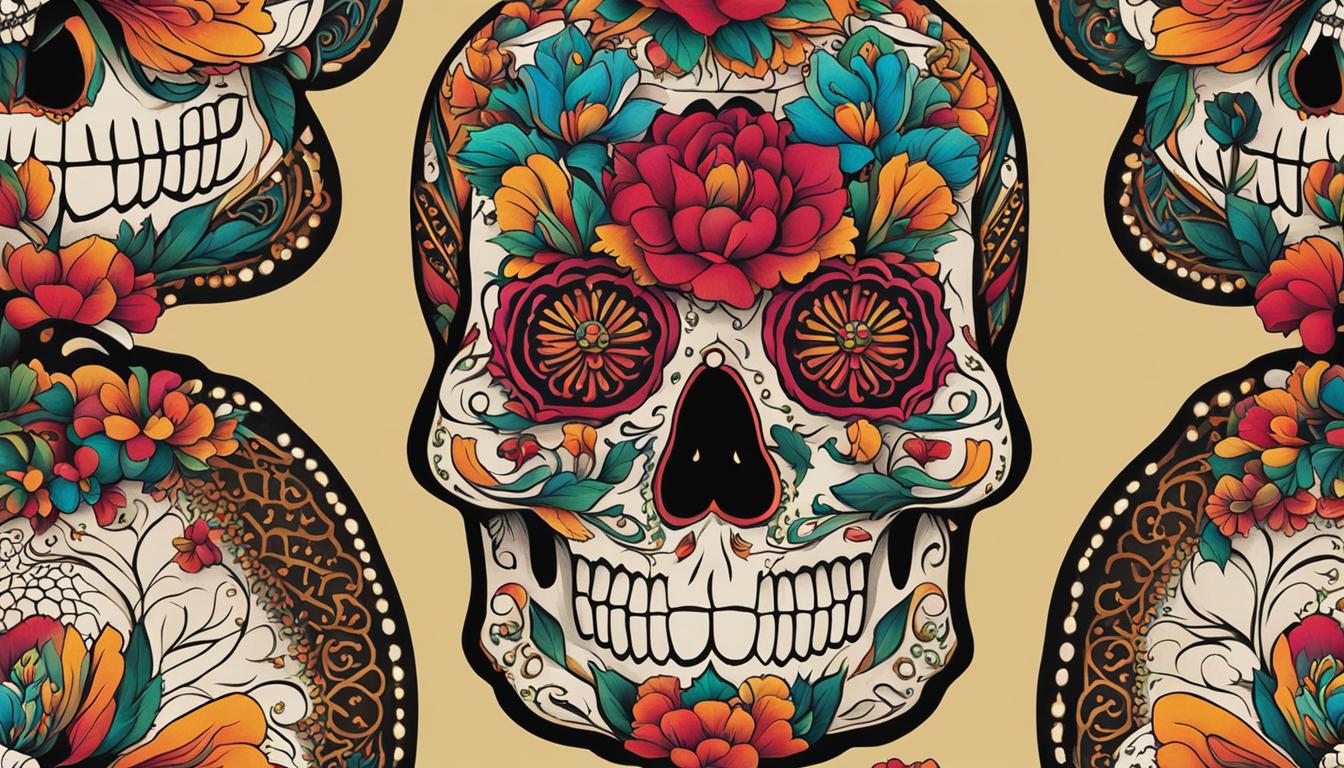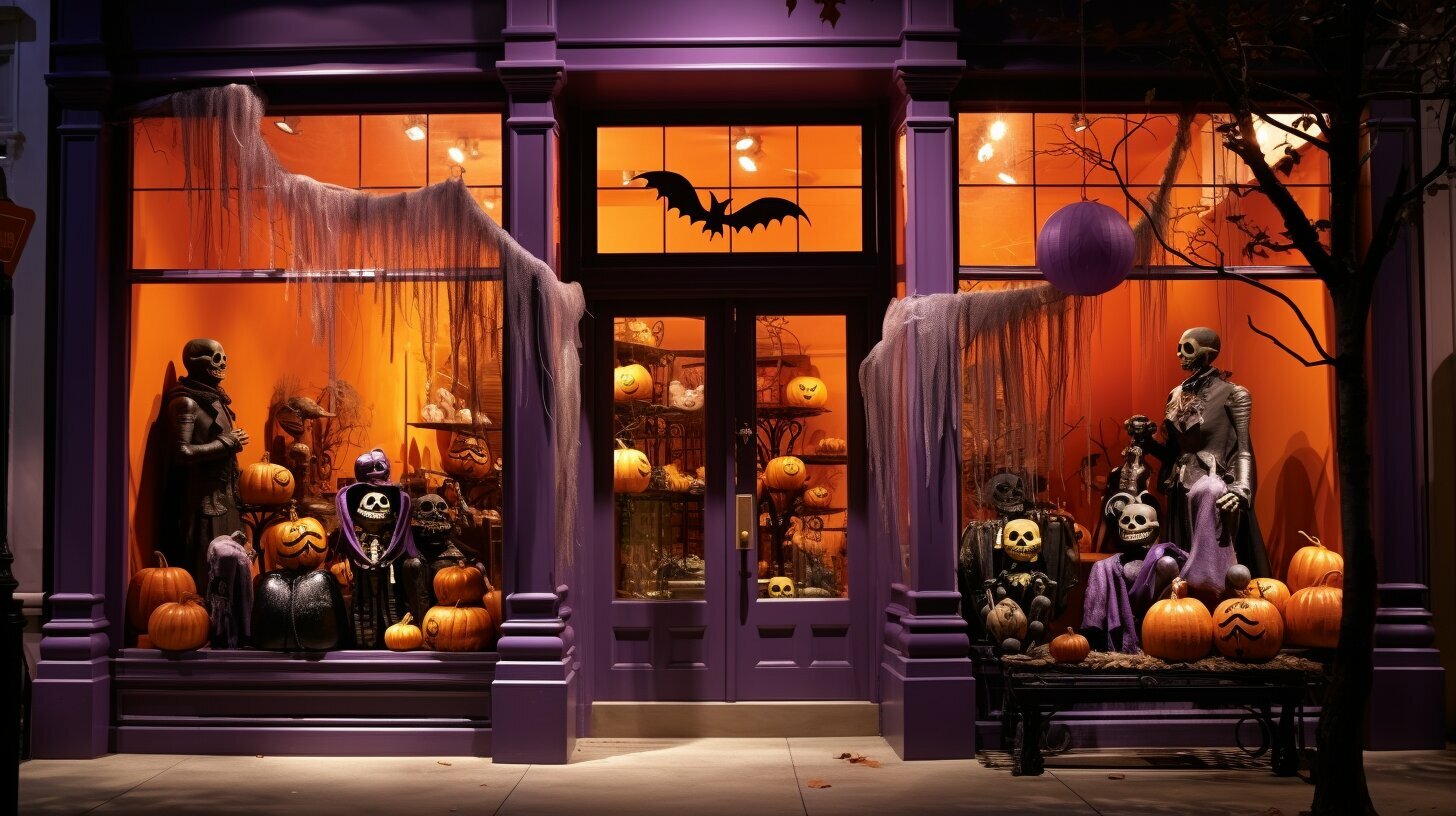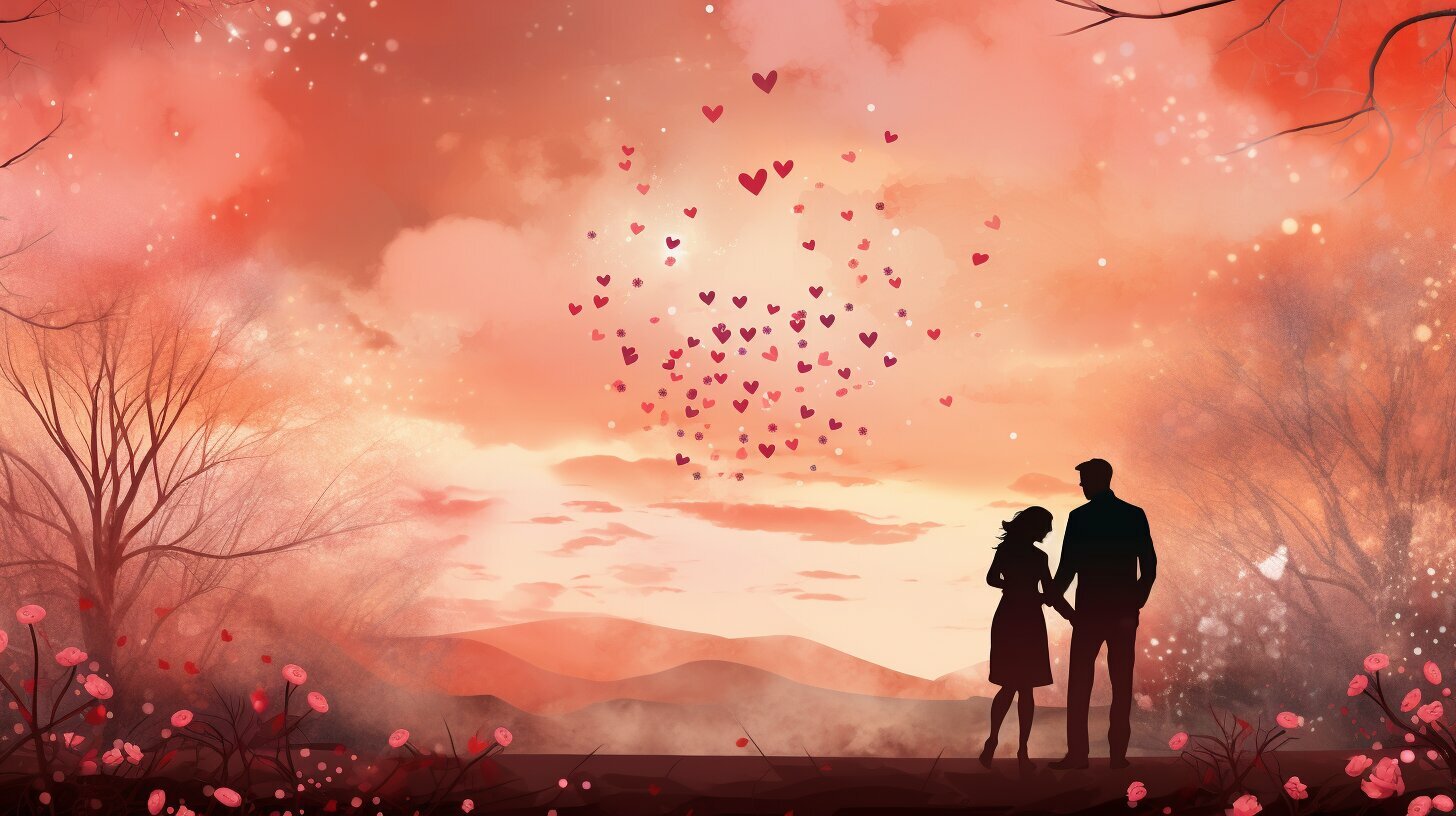The Day of the Dead is a captivating Mexican holiday that is steeped in symbolism and cultural significance. One of the most iconic symbols of this celebration is the Day of the Dead skull, also known as the sugar skull or calavera. These intricately designed skulls hold deep meaning and have evolved over time, reflecting the rich history and traditions of this festive occasion.
In this article, we will delve into the fascinating world of Day of the Dead skull designs and their meanings. From traditional to vibrant interpretations, we will explore the various styles and artistic expressions that have come to define this iconic symbol. Join us as we unravel the history, cultural significance, and artistic beauty of the Day of the Dead skull.
Key Takeaways:
- The Day of the Dead skull, also known as the sugar skull or calavera, is a symbol rich in symbolism and meaning.
- Day of the Dead skull designs have evolved over time, reflecting the cultural heritage and artistic expressions of this Mexican holiday.
- Skull art is a powerful representation of the interconnectedness of life and death, reminding us to embrace life while honoring the memories of the departed.
- The Day of the Dead is a celebration of life and a time to remember and honor loved ones who have passed.
- The global impact of the Day of the Dead has led to cultural exchange and understanding, spreading the rich traditions and symbolism of this holiday around the world.
Day of the Dead Symbols & Customs: Cemeteries
One of the most beautiful customs of the Day of the Dead is decorating the gravestones in cemeteries. This tradition dates back to pre-Hispanic times and is still widely practiced today. Families gather at the graves of their loved ones to clean and decorate them, creating a welcoming space for the returning souls. Cemeteries become a focal point of the festivities, with elaborate decorations and vibrant displays.
During Day of the Dead celebrations, cemeteries are transformed into colorful and lively spaces. Graves are adorned with marigold flowers, candles, and photographs of the deceased. Families also place food, drinks, and personal belongings on the graves as offerings to the spirits. These offerings are believed to help guide the souls back to the world of the living and provide them with sustenance during their visit.
“Cemeteries become a place of remembrance, reflection, and celebration during the Day of the Dead. It’s a time for families to come together and honor their ancestors, creating a deep sense of connection and continuity.”
The atmosphere in the cemeteries is one of both reverence and joy. Families gather to clean the gravesites, removing weeds and debris, as a way to show respect for their loved ones. Once the graves are clean, families decorate them with colorful papel picado (paper cutouts), candles, and sugar skulls. The vibrant colors and intricate designs create a visually stunning backdrop for the festivities.
The customs surrounding cemeteries during the Day of the Dead highlight the deep connection between the living and the deceased. It is a time to remember and celebrate the lives of those who have passed, to honor their memory, and to cherish the bonds that continue to exist. The decorations and offerings in cemeteries serve as a visual representation of this connection, creating a space where the living can come together with their departed loved ones and celebrate the cycle of life.
| Symbol | Meaning |
|---|---|
| Marigold Flowers | Symbolize remembrance and guide the souls of the departed back to their loved ones. |
| Candles | Represent the light that guides the spirits back to the world of the living. |
| Papel Picado | Colorful paper cutouts that add beauty and vibrancy to the decorations. |
| Sugar Skulls | Represent death and serve as offerings to the spirits. |
Day of the Dead Symbols & Customs: Sugar Skulls
Sugar skulls are an integral part of the Day of the Dead celebrations, representing both death and the celebration of life. These intricately decorated skulls hold deep meaning and symbolism within Mexican culture. The designs of sugar skulls often feature vibrant colors, intricate patterns, and personalized elements, making each one unique.
The Mexican skull, or calavera, is a traditional symbol of the Day of the Dead, dating back to pre-Hispanic times. The skull represents death, but it is not meant to be morbid or scary. Instead, it serves as a reminder of the cycle of life and the importance of remembering and honoring our ancestors.
| Sugar Skull Designs | Sugar Skull Symbolism |
|---|---|
| Sugar skulls are often adorned with flowers, such as marigolds, which symbolize remembrance and guide the spirits of the departed. | The skull itself represents death and the skeleton signifies our shared humanity. The vibrant colors symbolize the celebration of life even in the face of death. |
| The designs can also incorporate other symbols, such as hearts, crosses, or religious imagery, depending on personal beliefs and the intended meaning. | Sugar skulls can come in various sizes, with smaller ones used for decorations and larger ones representing departed loved ones. |
| The designs are often hand-painted, reflecting the creativity and artistry of the individuals who create them. | Each sugar skull is a unique representation of the deceased, honoring their memory and celebrating their life. |
The sugar skull has become a recognizable symbol of the Day of the Dead, not only in Mexico but also around the world. Its vibrant colors and intricate designs have captured the imagination of many, and it is now commonly seen in various forms of art, including tattoos, paintings, and jewelry.
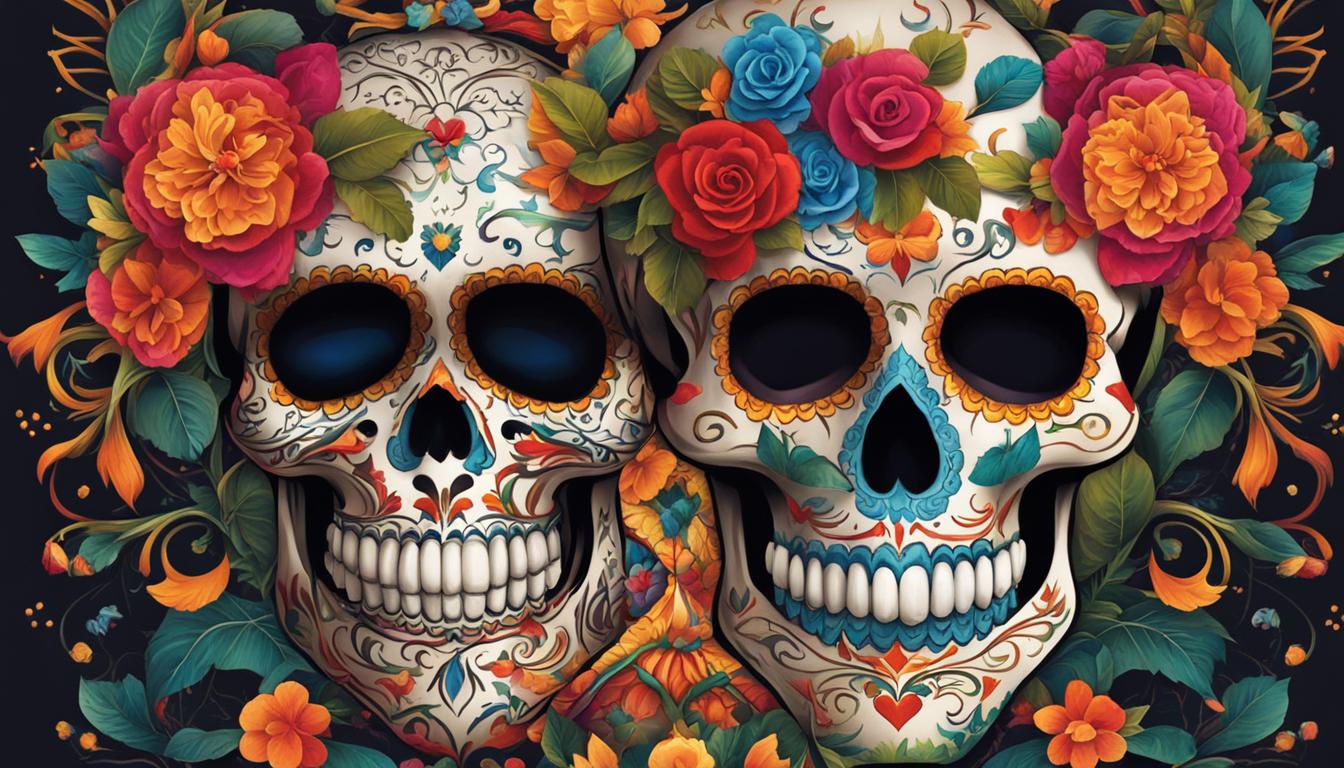
The sugar skull is a powerful symbol of the Day of the Dead, reminding us to embrace life while acknowledging the inevitability of death.
Day of the Dead Symbols & Customs: Marigold Flowers
Marigold flowers, also known as cempasuchil or flor de los muertos, hold special significance during the Day of the Dead celebrations.
These vibrant orange blooms are believed to guide the souls of the departed back to their loved ones, according to Aztec beliefs. The bright colors and captivating scent of marigolds are thought to attract and welcome the spirits during this time of remembrance and celebration.
The use of marigolds in Day of the Dead decorations is widespread, and they can be seen adorning altars, gravesites, and streets. The vibrant display of marigold flowers creates a visually striking and symbolic landscape, symbolizing the connection between life and death.
Symbolism of Marigold Flowers
The marigold flowers used during the Day of the Dead carry deep symbolism. They represent the fragility and beauty of life, as well as the fleeting nature of existence. The vibrant colors of marigolds are believed to attract the spirits of the departed, guiding them towards their loved ones’ altars and creating a welcoming path for their return.
Marigolds are also associated with the sun and its life-giving energy. During the Day of the Dead festivities, the marigold flowers help illuminate the path for the spirits, providing warmth and light as they make their journey back to the realm of the living.
“Marigolds represent the fragility and beauty of life, as well as the fleeting nature of existence.”
Table: Symbolism of Marigold Flowers in Day of the Dead
| Symbolism | Meaning |
|---|---|
| Vibrant colors | Attracting the spirits of the departed |
| Fragility | Symbolizing the delicate nature of life |
| Beauty | Recognizing the inherent beauty of existence |
| Sun association | Representing the life-giving energy of the sun |
The marigold flowers, with their vibrant colors and deep symbolism, play an essential role in Day of the Dead celebrations. They honor the cycle of life and death, serving as a bridge between the living and the departed. Through their visual beauty and captivating scent, marigolds create a vibrant and welcoming atmosphere, inviting the spirits to join in the celebration and be remembered by their loved ones.
Day of the Dead Symbols & Customs: La Catrina
La Catrina, also known as the Day of the Dead skeleton woman, is a stunning and iconic symbol of the holiday. She is often portrayed wearing an elaborate hat, elegant clothing, and a skeletal face painted with vibrant colors. La Catrina represents the Mexican society and serves as a reminder of the universality of death. Originally created by José Guadalupe Posada, a Mexican printmaker, La Catrina gained further recognition through the paintings of Diego Rivera. Today, she has become synonymous with the Day of the Dead and is a prominent feature in sugar skull designs and other festive decorations.
“La Catrina is a representation of Mexican society and highlights the idea that in the end, we are all equal, regardless of social status or wealth. She embodies the belief that death is an inherent part of life and should be celebrated rather than feared.”
– Mexican artist, Diego Rivera
La Catrina’s popularity has transcended borders, making her an internationally recognized symbol of the Day of the Dead. Her image can be found in art, fashion, and various forms of media, showcasing the global impact of this vibrant holiday. La Catrina serves as a powerful reminder to embrace life while honoring and celebrating the deceased, bringing people together in a joyful commemoration of the cycle of life and death.
Table: The Evolution of La Catrina
| Year | Significance |
|---|---|
| 1910s | José Guadalupe Posada creates the first images of La Catrina, originally as a satirical representation of the upper class in Mexican society. |
| 1940s | Diego Rivera features La Catrina in his mural, “Dream of a Sunday Afternoon in Alameda Park,” bringing her widespread recognition and establishing her as a symbol of the Day of the Dead. |
| 21st Century | La Catrina becomes a popular icon in Mexican pop culture, appearing in various forms of art, fashion, and media. Her image is embraced and celebrated by people around the world, further solidifying her status as a global symbol. |
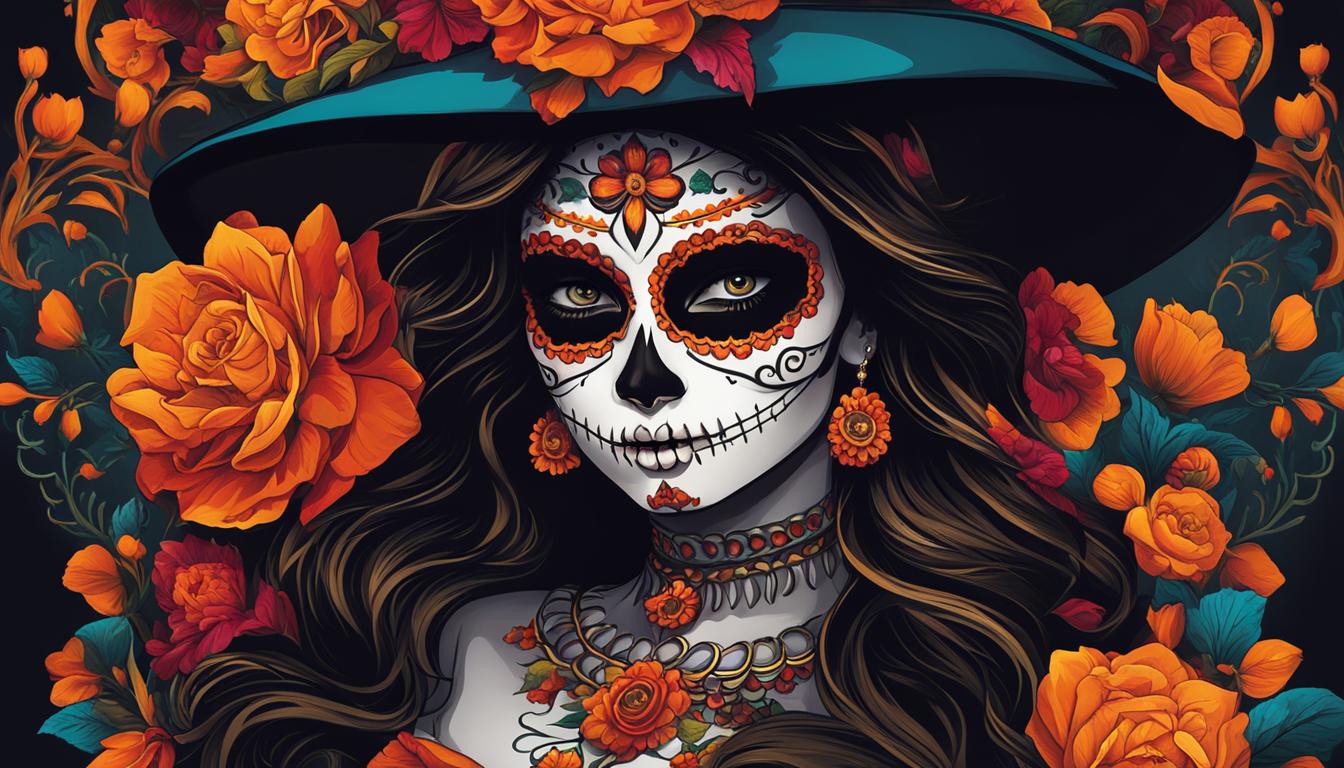
Day of the Dead Symbols & Customs: Parades (Comparsas or Muerteadas)
Parades, known as comparsas or muerteadas, are a vibrant and lively part of Day of the Dead celebrations. In cities like Oaxaca, these processions fill the streets with music, dancing, and elaborate floats. The comparsas feature costumed musicians and provide an immersive experience for participants to join in and celebrate the holiday. These parades bring the 2-D imagery of the Day of the Dead to life and showcase the community’s creativity and spirit.
The parades are a visual feast of colorful costumes, intricate masks, and traditional music. The streets come alive with the sounds of brass bands and the rhythms of drums. Participants, dressed as skeletons or in traditional attire, dance to the beat of the music, creating a vibrant and energetic atmosphere. Elaborate floats adorned with flowers, papel picado (colorful paper flags), and candles add to the spectacle, telling stories and honoring the deceased.
Parades like the comparsas or muerteadas not only entertain spectators but also provide a deeper understanding of the cultural and spiritual significance of the Day of the Dead. They serve as a reminder of the interconnectedness of life and death, celebrating the memories of the departed while embracing the joy of the present. These parades are a testament to the resilience and creativity of the communities that continue to keep the traditions alive and pass them onto future generations.
Beauty in Motion: The Comparsas of Oaxaca
The city of Oaxaca is renowned for its vibrant Day of the Dead celebrations, which include the spectacular comparsas. These parades feature various traditional dances, such as the Danza de los Diablos (Dance of the Devils) and the Danza de la Pluma (Dance of the Feather).
The Danza de los Diablos is a portrayal of the eternal battle between good and evil, with participants wearing elaborate devil masks and costumes. They dance through the streets, showcasing acrobatic moves and mesmerizing choreography.
The Danza de la Pluma is a reenactment of the conquest of Mexico by the Spanish. Participants, dressed as conquistadors and indigenous warriors, perform intricate footwork and dramatic storytelling, accompanied by traditional music.
These dazzling performances not only entertain but also pay homage to the indigenous cultures and historical events that have shaped Mexico’s identity. The comparsas of Oaxaca are a true testament to the rich artistic and cultural heritage of the region, offering a captivating and immersive experience for locals and visitors alike.
| Key Elements of Day of the Dead Parades | Meaning and Symbolism |
|---|---|
| Elaborate Costumes and Masks | Represent the spirits of the deceased and the vibrant celebration of life. |
| Traditional Music and Dance | Express the cultural identity and ancestral roots of the community. |
| Floats and Decorations | Pay tribute to the departed and create a visually stunning display. |
| Community Participation | Unite people and foster a sense of togetherness and shared celebration. |
Day of the Dead Symbols & Customs: Altars (Ofrendas)
Altars, known as ofrendas, play a central role in Day of the Dead traditions. These beautifully adorned spaces are created in homes and public areas to honor and remember departed loved ones. They serve as a focal point for families to gather, reflect, and celebrate the lives of those who have passed on.
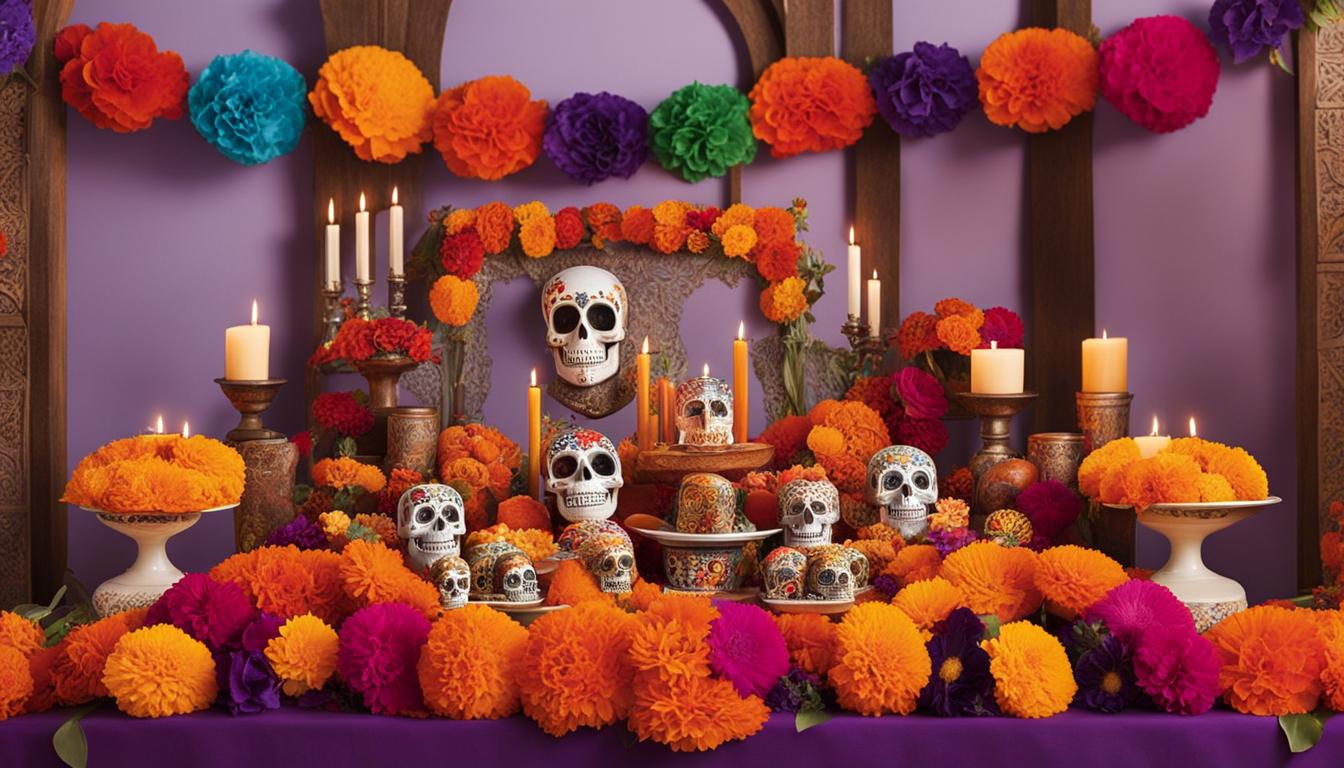
Papel picado, colorful decorative paper, is a common element in ofrendas. It is intricately cut into delicate patterns, representing the fragility of life. Candles are also prominent, symbolizing light to guide the souls back to their loved ones. Marigolds, with their vibrant orange color and sweet scent, are believed to attract and welcome the spirits.
| Elements of an Ofrenda | Meaning |
|---|---|
| Papel picado | Symbolizes the fragility of life |
| Candles | Represents light to guide the spirits |
| Marigolds | Attracts and welcomes the souls |
The ofrenda often includes personal items and photographs of the deceased, along with their favorite foods, drinks, and other belongings. These offerings are meant to nourish and comfort the spirits during their visit. Family members gather around the altar to share stories and memories, creating a space of connection and remembrance.
Creating Your Own Ofrenda
Creating a personal ofrenda is a meaningful way to honor loved ones and keep their memories alive. To create your own ofrenda, start by selecting a prominent location where it can be displayed. Then gather photographs, personal items, and mementos that represent the deceased’s life and interests.
- Choose a variety of marigolds to decorate the altar, placing them in vases or woven baskets.
- Add candles to provide light and warmth. You can use traditional votive candles or LED candles for safety.
- Include papel picado to add a festive touch to the altar.
- Arrange photographs and personal items on the altar, creating a heartfelt tribute.
- Offer favorite foods, drinks, and other items that hold significance to the departed.
As you create your ofrenda, take time to reflect on the lives of those you are honoring. Share stories, reminisce, and celebrate the impact they had on your life. The ofrenda serves as a bridge between the living and the dead, a place of love, remembrance, and connection.
Sugar Skull Art: Celebrating Life and Death
Sugar skull art is a vibrant and expressive form of artwork that celebrates the rich traditions and symbolism of the Day of the Dead. These intricate and colorful designs are created to honor the lives of loved ones who have passed away and to embrace the cycle of life and death. Sugar skulls, also known as calaveras de azucar, are a central symbol of the holiday and hold deep meaning for those who create and appreciate them.
The meaning of sugar skulls goes beyond their decorative appeal. They serve as a reminder of the temporary nature of life and the importance of cherishing each moment. Through the vibrant colors, intricate patterns, and personalized designs, sugar skull art captures the energy and spirit of the Day of the Dead. It is a celebration of life and a recognition of the beauty that exists in both life and death.
“Sugar skull art embodies the duality of life and death, the celebration of the deceased, and the remembrance of loved ones. It is a powerful symbol that transcends cultural boundaries and fosters a sense of connection and unity.”
Artists who create sugar skull art often draw inspiration from traditional Mexican folk art, incorporating elements such as flowers, butterflies, and religious symbolism. The vibrant and lively nature of sugar skull art reflects the festive atmosphere of the Day of the Dead celebrations. Through their creativity and artistic expression, these artists contribute to the preservation and continuation of a cultural tradition that holds deep meaning for many.
Whether displayed as paintings, sculptures, or intricate tattoos, sugar skull art is a visual representation of the rich heritage and customs of the Day of the Dead. It serves as a bridge between the past and the present, honoring the memories of loved ones while embracing the joy and celebration of life. Sugar skull art has gained international recognition for its beauty and meaning, making it a cherished symbol of the Day of the Dead around the world.
The Symbolism of Sugar Skull Art
Sugar skull art is imbued with symbolism that reflects the essence of the Day of the Dead. The skull itself represents death and serves as a reminder of the inevitability of mortality. However, the vibrant colors and intricate designs of sugar skulls symbolize the celebration of life and the belief that death is a natural part of the cycle of existence. Through sugar skull art, individuals can find solace in honoring the memories of loved ones and embracing the joy and vibrancy of life.
| Sugar Skull Symbolism | Sugar Skull Designs |
|---|---|
| The cycle of life and death | Bright colors and intricate patterns |
| The celebration of deceased loved ones | Personalized elements and symbolism |
| The temporary nature of life | Inspiration from traditional Mexican folk art |
| Embracing the joy of life | Reflection of festive Day of the Dead atmosphere |
Day of the Dead Coloring Books
Day of the Dead coloring books offer a creative and engaging way to immerse yourself in the rich culture and symbolism of this vibrant holiday. These books feature intricate sugar skull designs, elaborate patterns, and other Day of the Dead motifs that can be colored and personalized to your liking. Whether you’re a child or an adult, coloring can be a therapeutic and enjoyable activity that allows you to connect with the traditions and symbolism of the Day of the Dead.
Sugar skull coloring pages are especially popular in these coloring books, allowing you to explore the intricate details of this iconic symbol. From the delicate filigree patterns to the vibrant colors, you can bring these sugar skulls to life with your own artistic flair. Coloring these pages can be a meditative experience, as you focus on each stroke and color choice, creating a unique piece of art that reflects your interpretation of the Day of the Dead.
Day of the Dead coloring books also provide an educational aspect, as they often include information about the history, customs, and symbolism of the holiday. This allows you to learn more about the significance of the sugar skulls, marigold flowers, and other symbols associated with the Day of the Dead. It’s a wonderful way to deepen your understanding of this cultural celebration while enjoying a fun and creative activity.
| Benefits of Day of the Dead Coloring Books | Examples of Day of the Dead Coloring Books |
|---|---|
|
|
Whether you’re looking for a relaxing activity, a way to learn more about the Day of the Dead, or simply a creative outlet, Day of the Dead coloring books are a wonderful choice. They allow you to celebrate and embrace the vibrant spirit of this holiday while unleashing your creativity and personalizing the intricate designs and symbols. So grab your colored pencils or markers, and let your imagination soar as you bring the beauty and meaning of the Day of the Dead to life on the pages of these coloring books.
Sugar Skull Coloring Pages
Creating Your Own Altar: Honoring Loved Ones
Creating your own Day of the Dead altar is a heartfelt and personal way to honor and remember deceased loved ones. By personalizing the altar with meaningful items and decorations, you can create a space that reflects the unique lives and memories of those who have passed. Incorporate elements such as photographs, cherished objects, and favorite foods to evoke specific memories and connections. The altar serves as a physical representation of the bond between the living and the deceased, providing a place for reflection, remembrance, and celebration of life.
When building your altar, you can include traditional Day of the Dead symbols such as sugar skulls, marigolds, and candles. Sugar skulls, intricately decorated with vibrant colors and designs, represent the departed souls and act as a welcoming gesture for their return. Marigolds, with their bright orange petals, are believed to guide the spirits back to their loved ones with their vibrant colors and aroma. Candles provide illumination and symbolize the light that guides the souls during their journey. By incorporating these symbols into your altar, you create a meaningful and visually engaging tribute.
Personalizing Your Altar
When personalizing your Day of the Dead altar, consider the individual preferences and interests of your loved ones. Include their favorite foods, drinks, or mementos that evoke special memories. You might choose to display a collection of their treasured items, a favorite book, or a musical instrument they enjoyed playing. By incorporating these personal touches, you create a unique and heartfelt tribute that truly honors the lives and legacies of your loved ones.
Remember, there are no strict rules when it comes to creating your own altar. The process should be guided by your own emotions, memories, and traditions. Whether you choose to build a small altar in your home or participate in larger communal altars, the act of creating an altar allows you to connect with your loved ones, celebrate their lives, and keep their memory alive.
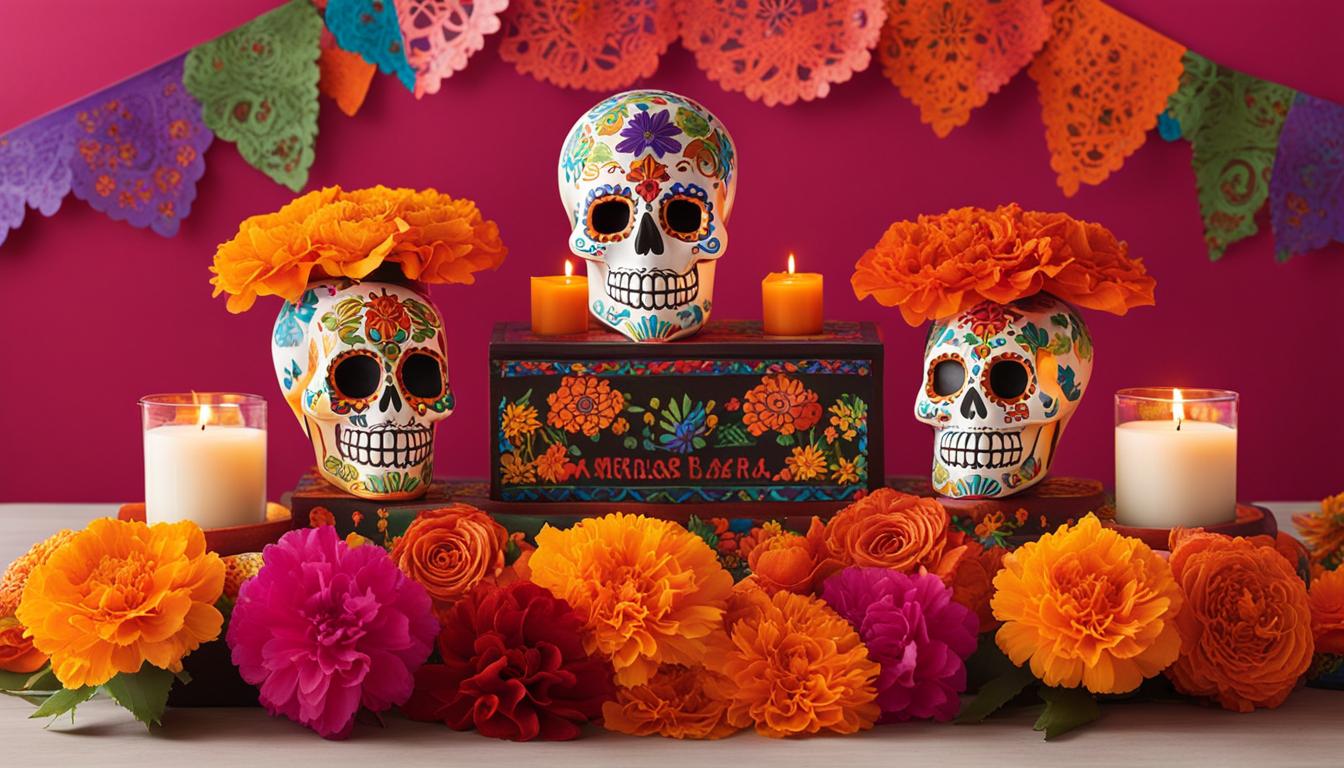
The Symbolism of Skulls and Flowers
Skulls and flowers are two prominent symbols in the Day of the Dead celebrations. These symbols hold deep meaning and significance, representing the interconnectedness of life and death and the importance of honoring and celebrating both.
The Symbolism of Skulls:
Skulls, represented by sugar skulls and La Catrina, symbolize death and the cycle of life. They serve as a reminder of the universality and inevitability of death, prompting us to reflect on the transient nature of our existence. The intricate designs and vibrant colors of sugar skulls are a celebration of life even in the face of death, emphasizing the joy and vitality that can be found in the midst of mortality.
The Symbolism of Flowers:
Flowers, particularly marigolds, play a crucial role in Day of the Dead traditions. Marigolds are believed to guide the souls of the departed back to their loved ones, serving as a vibrant pathway between the realms of the living and the dead. The bright colors and sweet scent of marigolds bring comfort and remembrance, transforming cemeteries and altars into spaces of beauty and connection. Flowers symbolize the fragility and fleetingness of life, reminding us to cherish the moments we have with our loved ones.
The significance of Day of the Dead symbols, such as skulls and flowers, extends beyond their visual representation. They evoke deep emotions and provoke contemplation about the cycle of life and the importance of remembering and honoring those who have passed. These symbols invite us to celebrate life while acknowledging the inevitability of death, fostering a sense of gratitude and appreciation for the connections we share with both the living and the deceased.
| Symbol | Meaning |
|---|---|
| Skulls | Symbolize death and the cycle of life |
| Flowers | Represent remembrance and guide the souls of the departed |
“Skulls remind us that death is an inevitable part of life, while flowers serve as a beautiful reminder of the connections we have with our loved ones.” – Unknown
The Evolution of Day of the Dead Traditions
The Day of the Dead is a vibrant and dynamic celebration that has evolved and adapted over time. As this Mexican holiday has spread beyond its borders, new interpretations and artistic expressions of the Day of the Dead traditions have emerged. Modern interpretations of this cultural celebration honor the past while embracing the present, creating a diverse and inclusive atmosphere.
While the core customs of the Day of the Dead remain intact, younger generations have infused their own creativity and perspectives into the festivities. They bring new energy and ideas that keep the traditions alive and relevant in today’s world. This evolution allows for a dynamic and ever-changing celebration that continues to captivate people from various backgrounds.
The cultural significance of the Day of the Dead continues to grow as communities around the world embrace and incorporate its traditions. International celebrations of this holiday foster cultural exchange and understanding, promoting unity among diverse communities. This global impact helps to preserve and promote the rich cultural heritage of Mexico, showcasing the beauty and depth of the Day of the Dead.
| Evolution of Day of the Dead Traditions | Modern Interpretations | Cultural Significance |
|---|---|---|
| The holiday has evolved and adapted over time | New interpretations and artistic expressions have emerged | Communities around the world embrace and incorporate its traditions |
| Younger generations infuse their own creativity and perspectives | Modern interpretations honor the past while embracing the present | International celebrations foster cultural exchange and understanding |
| The traditions remain intact while evolving with the times | Dynamic and ever-changing celebration | Global impact promotes unity among diverse communities |
Modern Interpretations of Day of the Dead
Modern interpretations of the Day of the Dead have brought new artistic expressions and unique perspectives to the holiday. Younger generations have embraced the traditions while adding their own creative flair, resulting in a blend of tradition and contemporary art. Artists from various backgrounds have used different mediums to explore the themes of life and death, infusing the holiday with new meanings and interpretations.
“The Day of the Dead is a celebration of the cycle of life and death. Through modern interpretations, we are able to honor our loved ones in a way that resonates with our own experiences and cultural context.” – Artist statement
This modern approach to the Day of the Dead has allowed for a deeper connection with the holiday’s cultural significance. It has also opened up the celebration to a wider audience, who are able to appreciate and participate in the traditions in their own unique ways. The evolution of Day of the Dead traditions showcases the resilience and adaptability of cultural practices, ensuring that they continue to thrive in the modern world.

| Country | Celebration | Features |
|---|---|---|
| United States | Day of the Dead festivals | Parades, altars, art exhibitions |
| Spain | La Castañada | Traditional Catalan celebration with sweet treats and roasted chestnuts |
| Japan | Obon Festival | Honors ancestors and involves lanterns, dances, and visiting gravesites |
| Philippines | Undas | Similar to Day of the Dead, families visit cemeteries and honor their departed loved ones |
Conclusion
The Day of the Dead is a captivating and vibrant celebration that honors the cycle of life and death. From the intricate designs of sugar skulls to the colorful marigold flowers, each symbol holds deep meaning and significance. Day of the Dead is a time to remember and celebrate the lives of our loved ones who have passed, embracing the joy and memories they have left behind.
As we participate in the customs and traditions of this holiday, we are reminded of the interconnectedness of life and the importance of cherishing every moment. Day of the Dead serves as a beautiful reminder to live life fully and to appreciate the time we have with our loved ones. It is a celebration that brings communities together, fosters cultural exchange, and creates connections across diverse backgrounds.
Whether through decorating altars, attending parades, or creating vibrant sugar skull art, the Day of the Dead allows us to honor and commemorate the deceased while celebrating the gift of life. This rich and meaningful tradition has made a global impact, spreading its cultural significance and inspiring people around the world to embrace their own customs and traditions. The Day of the Dead is a testament to the power of remembrance, love, and connection, and it continues to be cherished and celebrated by people of all cultures and backgrounds.
FAQ
What is the Day of the Dead?
The Day of the Dead is a Mexican holiday that celebrates and remembers deceased loved ones. It is a vibrant and joyous celebration of life and death.
What are sugar skulls?
Sugar skulls are colorful confections that are intricately decorated and hold deep meaning. They are a symbol of the Day of the Dead and represent death and the celebration of life.
What is the significance of marigold flowers during the Day of the Dead?
Marigold flowers, or cempasuchil in Spanish, are believed to attract the souls of the departed with their vibrant colors and scent. They guide the spirits back to their loved ones.
Who is La Catrina?
La Catrina is an elegant skeleton woman who is a representation of Mexican society and a reminder of the universality of death. She is one of the most iconic symbols of the Day of the Dead.
What are Day of the Dead parades?
Day of the Dead parades, also known as comparsas or muerteadas, are vibrant processions that fill the streets with music, dancing, and elaborate floats. They showcase the community’s creativity and spirit.
What are Day of the Dead altars?
Day of the Dead altars, also known as ofrendas, are created to honor departed loved ones. They are adorned with offerings such as candles, marigolds, sugar skulls, and colorful papel picado.
What is sugar skull art?
Sugar skull art is a popular form of expression and celebration of the Day of the Dead. Artists create intricate and vibrant designs, often using sugar skulls as a canvas to explore themes of life and death.
What are Day of the Dead coloring books?
Day of the Dead coloring books provide a creative outlet for people of all ages to immerse themselves in the rich culture and symbolism of the holiday. They feature intricate sugar skull designs and other motifs that can be colored and personalized.
How can I create my own Day of the Dead altar?
To create your own Day of the Dead altar, personalize it with photographs, favorite items, and meaningful decorations that reflect the unique lives and memories of your loved ones. Incorporate elements such as sugar skulls, marigolds, and candles to create a welcoming space for the spirits to return.
What do skulls and flowers symbolize in the Day of the Dead?
Skulls represent death and the cycle of life, while flowers, especially marigolds, symbolize remembrance and guide the souls of the departed back to their loved ones. Together, they represent the interconnectedness of life and death.
How has the Day of the Dead tradition evolved over time?
The Day of the Dead tradition has evolved and adapted to the changing cultural landscape. It has spread beyond Mexico and gained international recognition. Younger generations are keeping the traditions alive while infusing them with their own creativity and perspectives.
What is the significance of the Day of the Dead?
The Day of the Dead is a celebration of life, a commemoration of the deceased, and a time for families and communities to come together, share stories, and honor the memories of their loved ones. It is a reminder to live life fully and cherish our time with our loved ones.
How has the Day of the Dead impacted cultures around the world?
The Day of the Dead has become a global celebration that fosters cultural exchange and understanding. Communities around the world now host Day of the Dead events and incorporate the traditions and symbols into their own celebrations, helping to preserve and promote the rich cultural heritage of Mexico.


